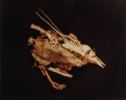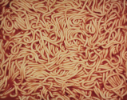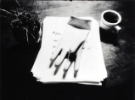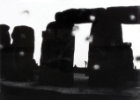Cover Story
The Infinite Hollis Frampton
A trove of the late artist’s rarely seen photographs comes out of hiding and enters the market

Hollis Frampton by Marion Faller, C. 1973
See examples of Hollis Frampton's photography
By Bruce Adams
Perched inconspicuously on a storeroom shelf at the Anthology Film Archives in New York City is a cardboard storage box labeled simply Number 6. It’s one of 10 boxes listed on an inventory of equipment and materials preserved from the University at Buffalo workspace of the late avant-garde filmmaker, photographer, writer, digital art pioneer and UB professor Hollis Frampton.
According to the inventory, box six contains 40 floppy disks, though in point of fact it’s nearly 200. The data on the fragile eight-inch disks cannot be accessed by today’s computers; it must be retrieved through a meticulous recovery process. For the moment their contents remain a mystery.
“Knowing Frampton’s work in the development of new hardware and software for digital manipulation of video, the presence of the disks alludes to potentially hundreds of files of early digital artworks and video clips,” says Sean Donaher, the executive director and curator of CEPA Gallery in Buffalo. Such a discovery would be something of a holy grail to the art world.
Donaher and his staff, in conjunction with fine art dealer Dean Brownrout Modern/Contemporary, are eagerly preparing for what promises to be a comprehensive exhibition and unprecedented sale of Frampton’s photography. Simply titled “Hollis Frampton,” the show, to open June 20 and run through the summer, will include work never before presented in a gallery setting. Pre-exhibition buzz caught the attention of nearby media arts center Squeaky Wheel, which is partnering with CEPA to present a simultaneous exhibition about Frampton’s time at UB’s Digital Arts Lab (DAL), while the Western New York Book Arts Center plans a third exhibit of Frampton objects and ephemera. Other events include lectures, screenings, an outdoor live concert/screening of the experimental film “Zorns Lemma” at the Burchfield Penney Art Center, a DAL roundtable featuring former colleagues and students of Frampton from around the country, and a final live concert and screening of his last work, “Magellan,” amid the grain elevators of Silo City.
The mystery disks, along with a vast cache of sundry materials supplied by the artist’s stepson, Will Faller Jr., have led the curatorial team down unforeseen paths. “When I came to Buffalo in 1989 to study photography and printmaking at UB, I was aware only of Frampton’s 16mm film work, and even that in a peripheral sense,” says Donaher. “It was really only when we started digging into the research for this exhibition that I truly began to understand the scope of his genius.”
A wagon full of books
Hollis Frampton by Marion Faller, 1975
That word genius pops up often when people talk about Frampton. It’s a term perhaps bandied about too freely today, but the artist’s penetrating intelligence (and innate bullheadedness) were evident early on. Born at the peak of the Great Depression, the son of a poor Ohio coal minor, young Frampton seldom spoke. “Borderline autistic” is how he described himself. The adult library card he acquired by age 6 nourished his insatiable appetite for books; a fresh batch packed his Radio Flyer wagon each Saturday. Hard science was the first of many passions.
Storied accounts of his early days abound. At 7, with his grandfather, he created a rudimentary “movie” by pasting catalog images to a belt connected to a hand-cranked phonograph motor. Before age 10, tests revealed he had a mental age above 18, getting him sprung from special education classes. Placed among gifted students, the uncommunicative boy studied French, the second of eight languages he would eventually speak.
Frampton’s first scholarship at age 10 was for life drawing classes at the Cleveland Museum of Art. At 15 he applied on his own to the prestigious Phillips Academy and received a full scholarship. After he graduated from Phillips, Harvard offered him a scholarship and then rescinded it when he intentionally blew a history test, ultimately failing to graduate.
The headstrong student, in his words, “allowed [himself] to be admitted” to Western Reserve University in Cleveland on the condition that he not be required to take courses he felt were irrelevant. The school agreed, but after Frampton amassed 135 credit hours, he was informed that he needed three “irrelevant” courses to complete a bachelor’s degree. So he left without one. He moved to Washington, D.C., where he visited the aging poet Ezra Pound almost daily in St. Elizabeth’s Hospital. Then, in 1958, he relocated to New York to pursue photography. Over the next decade or so, he documented artist friends, including Carl Andre, Frank Stella, Larry Poons, James Rosenquist and John Chamberlain. Some of these photographs are included in the CEPA exhibition.
“I didn’t find it a picnic to be a photographer through the ’60s,” recalled Frampton in a 1979 interview, “not because photography was disregarded, although of course that was true, but because my predicament was that of a committed illusionist in an environment that was officially dedicated to the eradication of illusion and, of course, utterly dominated by painting and sculpture.” Avant-garde filmmaking was about to take off in New York, and by the mid-’60s Frampton was a leading artist and theoretical prophet in the field, for which he is now best known.
“Hollis Frampton wasn’t just one of the great experimental filmmakers; he was a model for 21st-century art makers,” says Peter Lunenfeld (MA ’88), professor and vice chair of UCLA Design Media Arts, and one of many current media experts who got their start at UB’s Center for Media Study (now the Department of Media Study), which Frampton helped design. “He combined the four major waves of optical media in one career, moving from photography to cinema, to video, to digital media.”
Indeed, Frampton was one of the earliest explorers of audio and visual digital media, writing and testing hundreds of computer programs, and formulating dozens of hardware devices, to produce a computing environment useful for the arts. This groundbreaking technology included a frame buffer that enabled images to be stored on any computer and manipulated in real time, something not previously possible. Together with media artist Woody Vasulka he created UB’s Digital Arts Lab, which implemented and further developed these emerging technologies. The DAL was soon serving students from various departments throughout the university.
“It was the first program in the country devoted to the study of digital arts,” says Tony Conrad, a SUNY Distinguished Professor in Media Study who taught alongside Frampton in the early days of the department. “That was at a time when students built their own computers out of mail-order kits; everyone had a different idea of what could be done with the unexplored turf of ‘digital art.’”
One word per second
Hollis Frampton by Marion Faller, 1972.
Frampton was brought to UB in 1973 by Gerald O’Grady, the first member of a renowned community of groundbreaking filmmakers and videographers at the university, including, in addition to Conrad and the husband-wife team of Woody and Steina Vasulka, James Blue, Paul Sharits and Peter Weibel. (This era is documented in the massive tome “Buffalo Heads,” published in 2008 by MIT Press.) “I did my master’s after [Frampton’s] death,” says Lunenfeld. “So I never knew him, but in those days it was impossible not to know of him. I’ll never forget the first time I saw his masterpieces ‘Nostalgia’ and ‘Zorns Lemma.’ They proved to me that he was a protean artist; the intersections of sound and image he created stay with me.”
“Zorns Lemma” (1970), named after a proposition in mathematical set theory, is arguably Frampton’s most important work. The film begins in darkness with a woman reciting from an archaic reading primer used for teaching the alphabet. The central part is silent, as the 24-letter Latin alphabet repeatedly flashes on the screen, one letter at a time in one-second intervals. With each sequence, a new letter is swapped with a random image until the entire alphabet is replaced. The final segment is an extended shot of a man, woman and dog walking into the snowy distance as several alternating voices recite a passage from “On Light, or the Ingression of Forms” by Robert Grosseteste—one word per second.
London-Salisbury train by Marion Faller, 1972
Entire treatises have been written on “Zorns Lemma.” Some see it as a “cryptic autobiography,” in which young Frampton learns verbal language, moves to New York and progresses from verbal to visual language, and then departs for the countryside. (In 1974 he moved to a farmhouse in Eaton, N.Y., with his wife, photographer Marion Faller, and her son.) There are plenty of alternative readings. With its filmic temporality, system of order and substitution, and references to fire, water, air and earth, there may be an elemental truth encoded into its dense and resonant structure that supports a diversity of metaphoric and transcendent interpretations. You don’t so much watch “Zorns Lemma” for the enjoyment of watching; you watch it for the gratification of thinking about it later.
Frampton is widely known as a pioneer of structural film, a term he felt lacked sufficient specificity to describe his work. Influenced by Marshall McLuhan’s assertion that “the medium is the message,” structural filmmakers explore the material properties of film itself—fundamentally a series of 24 still images per second arranged in some order—rather than focusing on narrative and other cinematic conventions. Frampton’s films were often based on mathematical or scientific concepts. In 2012, much of his work was released on Blu-ray and DVD by the Criterion Collection. He was also known as a prolific and erudite theorist, and selections of his writings, collectively titled “On the Camera Arts and Consecutive Matters,” were published in book form by MIT Press in 2009 and reprinted this year.
“Hollis was a deep well of knowledge in a spread of fields that carpeted the humanities and sciences alike,” says Conrad. “A class or conversation with [him] was always sprinkled with sparkling witticisms, critical twists and original thoughts shooting in all directions.”
One of Frampton’s noted conceptual constructs was the “infinite cinema,” composed of all film of any kind ever made. A “metaphor for consciousness,” he once called it, which postulated that all cameras, projectors and film are part of an enormous single machine that powers the infinite cinema. “A still photograph is simply an isolated frame taken out of the infinite cinema,” he explained.
Flying cabbage and soy sauce pistols
Hollis Frampton by Marion Faller, 1974
Frampton continued making these “isolated frames” throughout his life, frequently in collaboration with Faller, who was also, says Brownrout, a “meticulous steward” of Frampton’s work until her death in 2014. “She made sure much of his artwork, films and personal archives are preserved in museums and institutions across the country.” Little of this work has previously been available for purchase. With growing international interest in the artist in recent years, Brownrout and Frampton’s estate agreed that now is the time to make this work available.
Safe to say, Donaher concurred. “My entire presentation [to Donaher] consisted of two words,” recalls Brownrout: “Hollis Frampton.” Donaher’s immediate response: “How does summer 2015 sound?” The exhibition will cut across the broad spectrum of Frampton’s photographic output, including early documentary photos and images used in “Nostalgia” and “Zorns Lemma.”
Also included will be examples from the series “ADSVMVS ABSVMVS,” in which objects, plants and dried animals are photographed against a black background, like scientific specimens. Each is exhaustively documented with deadpan earnestness in the accompanying text. “Frampton’s sense of humor is widely evident throughout his work, both in title and topic,” says Brownrout. “[His] works with found objects…or throwing a typewriter into a burn pile in the woods and calling it a sculpture entitled ‘Torments [Tortures] of the Text,’ follows a conceptual path started by Duchamp.”
“Sixteen Studies from Vegetable Locomotion”—a series done with Faller—depicts vegetables shot in rapid sequence against a gridded backdrop, similar to the motion studies of pioneering photographer Eadweard Muybridge. “Zucchini squash encountering sawhorse,” for example, shows a particularly large zucchini slamming against a wooden sawhorse, with predictable results. “Savoy cabbage flying” is doubly ironic since the camera follows the subject, in direct opposition to the customary stationary lens and grid. “Watermelon falling” beat David Letterman to the gag.
When color copiers were new, rare and prohibitively expensive, Frampton was invited to Everson Museum of Art in Syracuse to make art using one, much as Andy Warhol used serigraphy when it was still considered a commercial medium. In his “By Any Other Name” series, the artist copies various food labels, assigning witty misreadings of the packaging (e.g., “Thick Soy Sauce Brand Pistols”) to the cheerfully banal pop imagery. Frampton considered Xerox, like photography, to be a “democratic medium” that should be accessible to the general public. Now, for the first time, these will be.
Frampton died of lung cancer in 1984 at age 48. His final years at UB were spent working on his unfinished “Magellan” project (a film intended to be viewed in daily segments over 371 days) busily writing computer software programs to organize images for this work. Among other things, Frampton was perhaps one of the first people to understand the potential of the computer as personal creative instrument. He once wrote: “As an image tool, however, it is still young. However, we’re optimistic. Things have their natural time, they come and go.”
The same could be said for people. “When Hollis was here,” says Conrad, “he did nothing but smoke, drink beer and hack ceaselessly at his computer programs.” The lifestyle took its toll, and Frampton’s natural time was cut short. Donaher sums up what many others have said: “It makes you pause and wonder what his impact on the field would be today if he hadn’t died so young.”
Bruce Adams is an artist, educator and writer living in Buffalo.
A Selection of Frampton's Photographic Works
Long ago and far away, there was a magical place called the Digital Arts Lab or DAL for short - on the Main Street campus of UB. It was run by a mad man named Hollis Frampton.
It looked and felt almost identical to Buffalo Labs, but was smaller. I hung out there and built my first (working) computer from a bare circuit board and components. It had 2 8" floppy drives that held a huge 250kB each and cost $400 a piece and it ran CP/M.
Others there were working on building a frame buffer from scratch or writing a large image processing system called Imago (written all in Z80 assembler - I don't believe it was ever finished.)
A couple of other people were composing music on their CP/M computer using hexadecimal input. They liked it because it corresponded naturally to 16th notes.
It was really a makerspace, but, AFAIK, the term had not yet been invented.
Great writing, really looking forward to seeing the show.
Reading Bruce Adams' piece on Hollis Frampton brought me back to my days at UB when, as a media studies minor, I took a class with Paul Sharits. In the middle of class, he excused himself for about 20 minutes to write an idea in his notebook. It was one of the most memorable moments of my education, learning to capture an idea while it was in the air. Although I was there during Frampton's reign, and inspired by him, I only got to take a class with one of his graduate assistants. Those were great days, studying film criticism with Dwight Macdonald and creative writing with Raymond Federman. Articles like this help keep the memories alive.
What little I knew about Hollis Frampton (other than that he was the late husband of my beloved professor, the late Marion Faller) was that he was an artist so avant-garde that no one quite knew how to categorize him, much less understand his work and its relevance. Thanks to Bruce Adams for an interesting, illuminating and insightful article.
I am looking forward to reading this article more carefully. However, after a quick scan of it, I would like to comment on Hollis Frampton. I came to UB for graduate work at the Center for Media Studies, in the late 1970s. It had been my good luck to already receive much recognition for my film work. Further, the Center offered me their one teaching fellowship.
Now, many decades later, I remain engaged as film/dvd maker. However, no thanks to the Center for Media Studies (that did give me a degree with a 4.0). No thanks to Hollis or the other arrogant professors. They are/were undeserving of their extreme self-love and did their best to discourage students.
I am grateful that I did recover some sanity after my misfortune at UB. After UB, I put much energy into healthcare to the very underserved in my country, Latin America, and southern Africa. In part, I was trying to atone for damage that was directed at most students by Frampton and his colleagues.

















![260. Savoy cabbage flying [var. “Chieftain”]. From Sixteen Studies from Vegetable Locomotion, Hollis Frampton and Marion Faller. Photograph, 1975. Copyright Estate of Hollis Frampton](/content/dam/www/atbuffalo/Summer2015Issue/HollisFrampton/Frampton-055-1.jpg.thumb.100.140.jpg)
